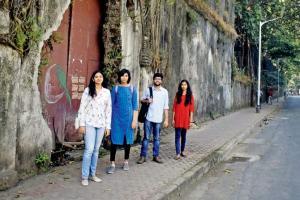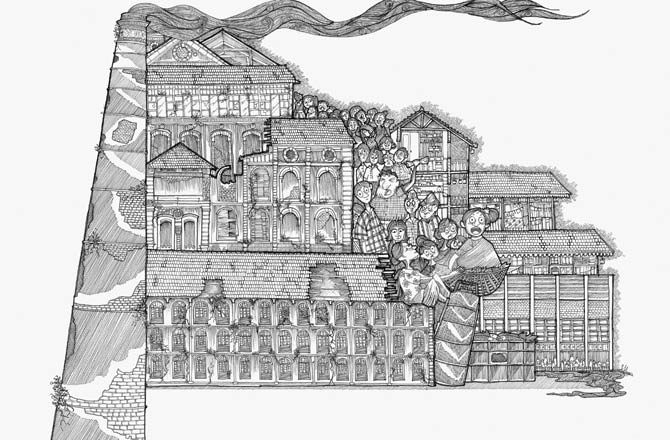Mumbai's mills churned out not just textiles, but also an entire culture of their own from home-grown veggies to theatre troupes. Lost now, five young architects are trying to capture what's left of the memories through illustrations and mind maps

The group has graduated from Prabhadevi's Rachana Sansad Academy of Architecture. Pic/Ashish Raje
Naigaon resident Amit More remembers the annual Ganeshotsav festivals in Wadala being replete with puppet shows and tamasha troupes. More's father and grandfather worked at the Bombay Dyeing mill Speaking of his early childhood, more, now 35, says, "The mills worked in three shifts. So, whenever these performances were organised in the evening, the night shift guys would assemble just to watch them perform and then go back to work at midnight."
Under the patronage of mill workers, numerous local tamasha troupes formed and flourished in 19th century Bombay. These performances, inspired from the Konkan and ghat regions of Maharashtra, were mostly organised during the Ganesh festival. Additionally, there would be traditional theatre shows, Yakshagana, from Karnataka and puppetry from Andhra Pradesh.
Architect Simran Arora, a resident of Colaba, says, "Girgangaon once employed thousands of workers and encouraged mixed migration of people. The workers and their families didn't imagine a life outside the chawls. They created their own culture, distinctive from the rest of the city. Their cultural shows were quite common then, but unfortunately the spirit has died down now."
Documenting what was lost
The Great Bombay textile mill strike of 1982 was the beginning of the end of an era. Right after the assassination of the charismatic Dr Datta Samant, who helmed the movement for better wages for factory workers, the stone chimneys that defined the Mumbai skyline for over a century-and-a-half were replaced by skyscrapers. But, as the city's largest cotton-manufacturer India United Mills continues to stand vacant and forgotten on 600 acres of land in Girangaon — literally 'mill village' and spanning Grant Road and Parel, not to be confused with Girgaum — five former architecture students have joined forces to document a culture that the city lost along with a defining industry.

As a large part of Mumbai's character flourishes in its chawls, this illustration by Simran Arora glorifies these structures, located close to a mill and its chimney
All 22-year-olds, Arora, Dhruv Vairagi, Samruddhi Shimpi, Akruti Murhekar and Meghna Dhadda spend the time they can spare from their full-time jobs for what they have called very simply The Culture Project, making regular stops at these historic industry units. "Today, while commuting in a local train, one can catch a glimpse of these dilapidated structures, designed in the English style with arched windows, and other neo-classical elements. This brought us to the question; why have we forgotten these architecture-rich buildings?" asks Arora, whose Colaba childhood has exposed her mainly to the Colonial style of architecture.
The project began, incidentally, when the five were still studying at Prabhadevi's Rachana Sansad Academy of Architecture, with the idea of mapping these mills. Navi-Mumbai resident Vairagi, an architect at Fort's Malik Architecture, says, "During our fifth year in college, we were asked to choose topics for a thesis project. While Simran decided to tap historical structures like the mills, Akruti wanted to focus on the forgotten forts of Mumbai. I focused on the Belapur fort that is significant with respect to the Peshwa era. Together, we started exploring these hidden gems. A plethora of information is available on the Internet about these mills and their history, but we thought of
going beyond that to record the culture so that our city never forgets that period."
The streets that run past
Where straight-up images are missing from a period when photography wasn't an every-minute passion, the architects have created illustrations that take one back in time to the city's old fabric, its bustling streets and the locals, who have moved out of cramped homes to urban pockets. Shimpi, a Thane resident who says Mumbai fails in comparison to the planned infrastructure of the 'Lake City', says, "Only making graphics and recording intricate details were never enough. We needed to meet the locals, who were a part of this community for decades, to tell us tales from the past. And so we did. While most workers have either passed away or moved out, some continue to stay in the chawls that sprung up near the factories. Their descendants however have moved on. It is truly the end of an era."
Among the observations the team made, while documenting the culture, says Vasai-based Murhekar, was how the streets themselves were different around the mills. Much of the vegetables sold here are grown along the railway tracks in Bandra or at farmlands in Panvel. "Therefore, they have a unique flavour and quality. Fish, too, are brought in from Worli village and Mazagaon dock. Every day, fresh produce is transported to this market. They have not been influenced by the modern ways of importing goods. In most other parts of the city, these items are sourced from vendors." The group is recording these details through mind maps, illustrations and text; information for which is sourced from the locals.
Beyond the mall to the museum
A key feature of these factories is the chimney. Simran explains, "Even if you are 500 metres away, you can see the tall chimneys. It is a defining factor. Mumbaikars need to orient themselves with the chimney; it cannot be demolished just to make way for skyscrapers." Recalling a book by Darryl D'Monte titled, Mills For Sale: The Way Ahead, she recalls that the Brihanmumbai Municipal Corporation (BMC) said that if they get the disputed land — some mill lands are in an ownership struggle between BMC and NTC — they would turn these into museums, preserving the true essence of the mill culture.
"Charles Correa, too, made proposals to convert them into public spaces, but nothing concrete has come into being yet. It is essential that we return these places, which once belonged to the public back to the public. People need to see the architecture from the inside to believe how exceptional it is. From state-of-the-art pipeline fixtures to the drainage system, everything is intelligently designed." The group hopes that their research helps future architecture students in the city. They also hope that the civic body if ever converts these mills into museums, it uses their work to help build the historic site.
Catch up on all the latest Mumbai news, crime news, current affairs, and also a complete guide on Mumbai from food to things to do and events across the city here. Also download the new mid-day Android and iOS apps to get latest updates
 Subscribe today by clicking the link and stay updated with the latest news!" Click here!
Subscribe today by clicking the link and stay updated with the latest news!" Click here!









